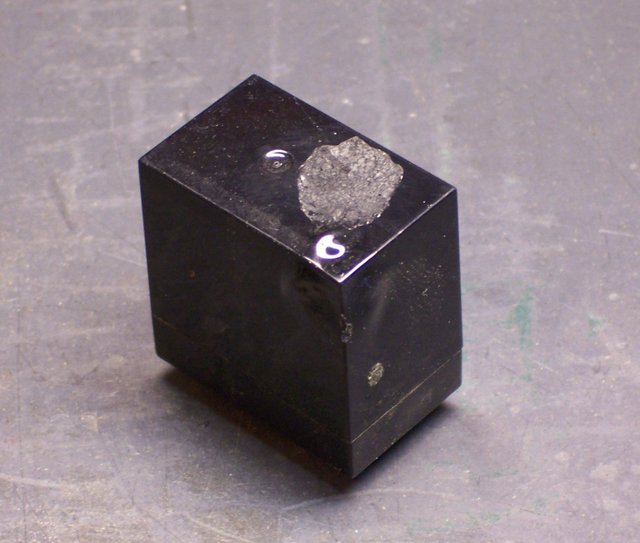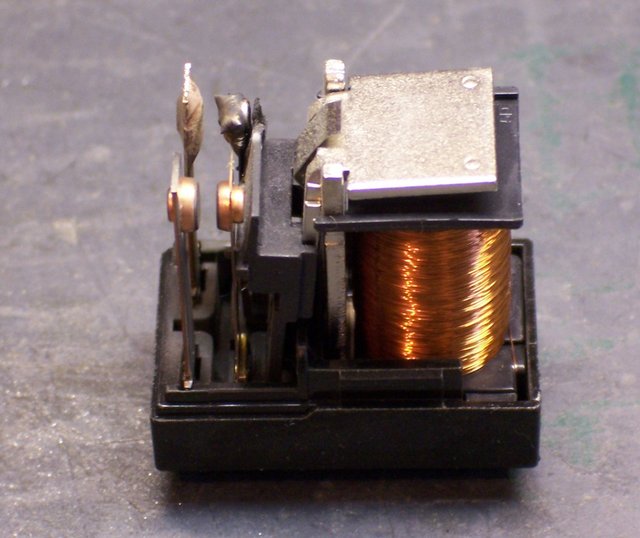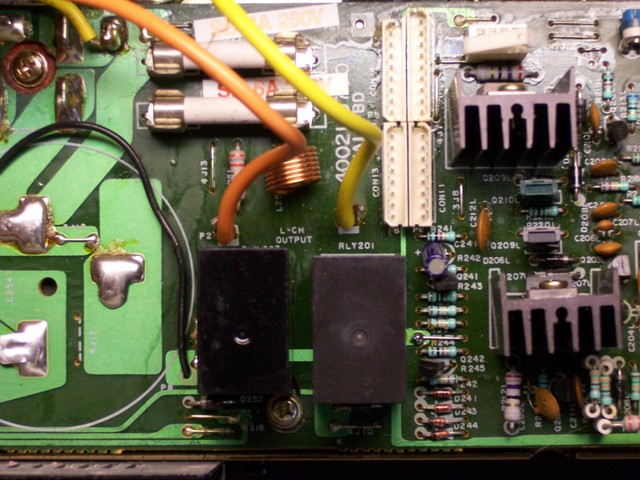In the late ’80s, almost certainly 1988, I used some of the money from my summer job to order an SAE (Scientific Audio Electronics; no longer in business) A502 amplifier from the DAK (Drew Alan Kaplan; no longer in business) mail-order catalog. The A502 is a two-channel solid-state audio amp rated for 200W per channel — but it’s as heavy as a tank (40-50 lbs) and actually able to live up to the promised wattage, unlike many smaller amps and modern receivers. At a comfortable listening level, the volume meter LEDs don’t even flicker on.
I’ve kept the amp and used it on and off since then, using it continuously for casual listening and home theater movie-watching for the last thirteen years. It’s never given me any trouble, and it performs admirably.
So admirably, in fact, that I’ve been shopping for more on eBay. In late December 2005, I bought two advertised as partially working; and this May, I finally repaired the first of them.
Replacing the SAE A502 Speaker Relay
The first of the two amps was advertised as having both A and B speakers work on the right channel, but only the B speaker work on the left channel. When I received it, I hooked up speakers to confirm the symptoms, then opened the amp to look around. The problem was immediately apparent:
Transient currents can generate popping and other unpleasant noises when a power amplifier is turned on. SAE designed around that problem by inserting relays between the output transistors and the speaker jacks, with delayed activation. Power on the amp, 2, 3, CLICK, and the speakers are engaged. Plenty of the time for the transients to disappear. And it works — my speakers are dead silent when turning the amp on and off.
Well, it works until one of the relays gets a little, um, melty.
I have no idea what happened to vaporize the contact, but I bet it was impressive. ![]() [Ron Tozier, local TV and electronics repair wizard, suggests that the contact was probably slightly oxidized, and the extra resistance led to heat buildup and eventual catastrophic breakdown.]
[Ron Tozier, local TV and electronics repair wizard, suggests that the contact was probably slightly oxidized, and the extra resistance led to heat buildup and eventual catastrophic breakdown.]
Now, although the relay is DPST, the amplifier circuit uses both contacts in parallel. So in theory, I could have cleaned the slag off the melted contact to make sure it stayed out of the way, polished the remaining contact, and resumed operation.
I really wasn’t comfortable with that idea, though. SAE put DPST relays in there for a reason, and I wasn’t really interested in changing their design. So I looked for a replacement relay, with no success. Google found me nothing to match the Matsushita part number, Digi-Key had no matches, and searching online surplus catalogs didn’t get me anything that matched the coil and current specifications with even close to the same form factor. So I set the amp aside until I could find a replacement relay, and kept searching occasionally.
At Last, a Relay
This April, after over a year of fruitless searching, I checked Digi-Key again, and they had the relay listed! Unfortunately, they had a minimum order of something like 108 pieces, and I didn’t need to fix 108 amps. Fortunately, one of their techs was able to cross-reference the relay, and in short order I had a bagful of perfect replacements. (I know, I don’t need to fix a bag of amps — but being prepared to replace another relay at some point in the future is worth a few extra bucks not to have to track them down again.)
The board is a pain to take out because it’s bolted down to greased heatsinks, it has huge power-filtering capacitors mounted on the back side, and its cables are bundled such that they’re too short to pull the board out. Bleah! But after dealing with the mechanical issues, it was only a few minutes work to remove the old relay and solder in the replacement.
The new relay (installed as RLY201, the right one) has a matte finish whereas the original was shiny, and its body sits a little lower with respect to its contacts, but those are insignificant issues. It fits, and that’s what counts.
The silk-screened circle to the left of the relays, BTW, is the footprint of the filter capacitor on the other side of the board.
Test Driving the New Relay
I threaded the board back into position in the chassis, bolted it back into place, and made sure the wires were all routed appropriately; but I didn’t close the case yet, as I wanted to test the new relay first. I plugged the amp into a power strip that was switched off, switched on the power strip, pushed the “On” button on the front panel, and POP! There was a moderately loud bang and a moderately bright flash, and I shut off the amp and the power strip quickly to have a look.
Strangely, the flash came from the right rear of the chassis — the opposite side from where I had replaced the relay. More strangely, I couldn’t find anything scorched or missing. I figured surely I’d see an electrolytic cap with its top blown off, or a resistor or diode vaporized, but nothing appeared wrong. I unmounted the board and checked the bottom side for brown scorch marks, but nothing wrong was visible there either.
My guess was that after the amp had been off for a year, some component got “tired” and the inrush current destroyed it; but even with repeated checking, I couldn’t find anything amiss. I found a copy of the schematic online and studied it in detail, but didn’t gain any new insight. I was reluctant to power up the amp and start poking around with a scope, for fear that the (hypothetical) broken component might lead to cascading, more expensive failures.
Testing the Repaired, Exploding Amp
Finally, I took the amp to visit Ron and ask his advice. I found his method of testing rather ingenious. This amp has 8A slow-blow fuses between the power supply and the power amplification section, not just a fuse on the line cord. We pulled all the 8A fuses and replaced them a pair at a time with 1A fuses, so we were powering up only one channel at a time. Anything seriously wrong would blow the 1A fuses pretty quickly, hopefully without doing further damage to the rest of the circuit.
After doing a quick check of the major capacitors and power transistors, Ron put an oscilloscope on the speaker outputs and I powered up the left channel — the one whose relay I had replaced. The scope stayed flat as it should — no unwanted DC component. Ron touched the line-level input, and we saw a low-amplitude 60Hz signal on the scope. All as expected.
Next, I pulled the fuses from the left channel and moved them to the right, where I had seen something blow up. Ron moved the scope and we powered up. The left channel output was flat as well — good so far. Ron touched the input, and we saw the same amplitude 60Hz signal on the scope.
Hey . . . what?! It works???
Well, yeah, it does. We couldn’t find anything wrong. I put the 8A fuses back in, took it home, reassembled the case and put it into my stereo, and it’s been running my surround speakers for a couple of weeks. Nary a problem since that day.
So what were the pop and the flash when I powered it back on? My best guess is that some piece of crud (dust bunny, cat fur, etc.) got shorted across a couple of high-voltage pads and lit up when the voltage said hello. Cort says he saw that happen a lot when he was repairing dusty arcade games back in the day.
One down, some more to go!



Thanks for your recounting of this and pics of the relay! happy listening
I have a 502 that appears to have a similar problem. There’s appearently a main relay on the board above the transformer. That relay will make it’s initial click but never re-engage. Could you please give me the site you got your relay from along with the model number. Could you also give me the site you found the schematic on. I love that amp and would hate to lose it for what appears to be a simple problem.
Ron, the schematic is available from a forum that’s the fourth Google result for SAE A502 schematic. The schematic keeps moving as different people’s web servers get retired, but I seem to be able to find the most recent link on the forum.
I got the relay from Digi-Key by using their online tech chat and having the technician cross-reference the part number on my old relay to something they have in stock. Note that the main power relay is different than the four speaker relays.
I don’t think your problem is as simple as the relay, though. If I understand you correctly, when you power the amp on, you hear RLY401 on the power supply board click, but you never heard the speaker relays click, no matter what you do. If that’s right, it’s not because the relays are bad, it’s because the amp’s protection circuitry is preventing them from engaging.
You probably have a problem in the preamp or power amp stages, and the amp has several different protection circuits to prevent e.g. a large DC signal from being sent to your speakers. The protection circuits prevent the Darlington pairs Q251/252, Q253/254, Q255/256, and Q257/258 from engaging the speaker relays. (You’ll see this when you pull up the schematic.)
Do you have an alternate repair plan for your amp if it gets beyond what you want to tackle? I can personally vouch for a friend of mine who’s been repairing TVs and electronics for about thirty years, and who glanced at the schematic and immediately comprehended the functioning of all the audio sections. I know it’s expensive to ship ($40+ each way, plus of course parts and labor for the actual repair), but you might consider that.
Whatever you do, don’t throw it away, even broken! It’s reparable by someone, somewhere, and it is a great amp. I’ve bought several broken ones myself, and am slowly going through to fix them up.
Great! I have a SAE I102 Integrated Amplifier and this is most likely the issue it has. Can you elaborate on the symptoms of the sound when you had a bad relay?
My speakers won’t play sometimes unless I turn the input device (Ipod) down really low and then crank the amp, this gives me constant sound, but still every once and a while a speaker will cut out.
I gotta keep this amp.
Mikal, I suspect your amp’s problem is not the relay. On mine, the relay simply wouldn’t make contact, and there was no sound (ever) from that speaker (A left).
If yours is sensitive to changes in the input volume and/or integrated volume control, I suspect you have a problem in the amp’s active electronics, probably (I’m guessing) in the preamp stages.
great post and good details..i have exact problem ..i checked relays…1 is burnt..would love an exact
part number so that i can get a replacement and an extra (just incase)
..would you know of any repair shops in toronto that would be best for an amp like this…my a502 is the mona lisa of all my electronics..would hate to put it on the wayside for something like this…thank you
Dabindranath Dhanie — I don’t remember the relay part number. But if you take the relay you have and contact Digi-Key’s live online tech support, they can cross-reference it to the one they stock. It’s duplicating the cross-reference they already did for me, but it’s probably easier than my finding my spare relays right now.
lol..was just thinking that it would be a nice idea to ask you to sell me one..i will have to look for that relay in canada..i did get the specs and number from digi-keys but since they ship in from the states…it would be better for me to check here first…cost with shipping and brokage plus duties ..i think that price is too much for now..will use the speaker B terminals for now …i will come back later to say where i got them just in case others here in canada is in the same position…thanks again
Good and helpful article. I’m have a Crate powered mixer CMX42P. Sometimes while I’m using it, a channel can go out, it is sometimes left and sometimes right. If I crank up the volume really loud, the channel will kick back on. I’ve cleaned out all of the pots and contacts so much this thing is practically sterile. Do you think the relay could be to blame? I’m having trouble locating it, but think it is a solid state relay that looks like a black rectangle? Sorry to post all of this here, I know this isn’t a fourm, but this is one of the closest related things I have found online about my problem. If you have any thoughts on this, that would be great. Thanks!
Justin, I haven’t worked with any Crate mixers and I don’t have a schematic in front of me, so I’m just speculating here. I can definitely tell you the first thing I’d do would be get a schematic.
I’d be very surprised to find a solid-state relay in the output section of a power amplifier. I don’t know much about them and I can’t think of any reason they wouldn’t work, but it doesn’t feel right to me. Also I wouldn’t assume that an amp I haven’t personally inspected even has output relays — certainly tube amps wouldn’t, and I don’t think it’s a given.
The reason I’d like to see a schematic is that I’d love to find the output of the mixer section where it feeds into the power amp section, tap that point, and see whether you still have a signal there at the times when your power output is cutting out. If you have a mix / master / monitor output whose volume increases when your powered output volume increases, it’s not a guarantee that it’s tied to the same place, but can you plug in there and use another piece of equipment to tell whether you have a signal there or not? That’ll help determine for sure whether the failure is in the mixer section or the power amp section.
I assume you’re using multiple inputs and the entire mixed output channel cuts out; or if you’re using only a single source, you’ve tried it in multiple inputs. If not, moving it around would be a good way to determine whether you have an input / channel problem or a mix / output problem.
Gentlemen
Its good to see so much interest in this equipment; I recently purchaced a I 102 online…. supposed to be working, anyway the power LED workes when plugged in, but as soon as the on button is depressed the 5 amp fuse blowes, any suggetions on how to diagnose?
Bob, I’m sorry but I don’t know much about any SAE gear except the A502s, and I don’t personally have a schematic for the I102. You may need to look for a professional repair for this one.
i couldnt get the replacement relay or my sae 502 so i tried your advice about filing the burnt tips..instead..all i did was bend it away until ie cap could just fit back on…and voila….it worked as good as new…goin to run it as is until it craps out permanently..then i will buy the so called min of 50 pieces online…lol….as i said before..thanks for your post..it helped me a lot…cheers
Hi, I have a ton of SAE equipment and love them. I just purchased a SAE x10a amp which is their Class A amp and it powers up the first LEDs light up, no audio output and no click. I pulled the cover and someone has removed the black cover on the relay and I suspect it is not working. But it doesn’t have the cover therefor I have no number to crossrefence the relay. This amp unlike my A502 has only one relay on the speaker output board. Any idea what relay I need or do I have to purchase some drawings to find the componet number?
Kenny, sounds like a good guess on the relay, but before you replace it you might want to test it. If you’re comfortable with a soldering iron, desolder it and pull it out of the circuit, then try putting 12V across the coil and see whether it engages. If it doesn’t, you’re probably right about needing to replace the relay — although be aware that there certainly may be more wrong with the amp than just the relay.
If you do need a part number for the relay, go to Jim’s SAE site — he has schematics for X-series amps. For a modest donation to a Dachshund rescue organization, he’ll send you a copy; he might even be willing to check the part number for nothin’.
Good luck with the repair!
Have a older SAE 502 amp guy used it to two sets of 4 ohm speakers, but not remembering if these amps liked a 2 ohm load or not back then what 1984, anyone still around or have any ideas lost booklets when we moved.